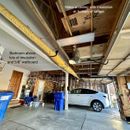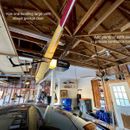Insulating an Unconditioned Attached Garage for a New EV?
I live in Colorado, just got a EV and noticed that the battery is not as efficient when the car is soaking in cold air overnight in my 3 car unconditioned attached garage (bedroom above) that has no insulation in the walls, ceiling or roof. I started to think what if I insulate the walls and then add a ceiling with insulation at the bottom of the trusses and insulation to the garage doors as well, perhaps that will help keep the garage warmer in the winter even though it is not a conditioned space. We have one electric car and one ICE car, when the ice car comes into the garage and it is 20°F outside the ICE car will warm the garage about 1.5°F degrees for 3 hours so inside the garage will go from 32° to 33.5°. My thought is when the garage is insulated it might keep it a bit warmer. When it got to -7°F the other night outside, my garage was 18°F so there must be some heat radiating from the attached house and along the heat in the concrete floor keeping it 25°F warmer.
But then I started to think batteries also do not like to be too hot also, in the summer the garage can get very hot, which is not good for the computer in the car and the car will turn on fans or AC to limit the hot temp (therefore wasting energy). By insulating the garage would I be making the garage even hotter creating an even larger issue because now it is draining the battery to cool the inside of the car? Or by adding plenty of soffit vents around the garage perimeter along with the existing large vent at the top of the roofline would that keep the roof cooler and therefore the garage cooler as well?
GBA Detail Library
A collection of one thousand construction details organized by climate and house part











Replies
I have a completely detached garage, insulated, but only heated when I need to work in there. Insulating the garage will moderate temps so the interior will be much closer to the day's average winter, and summer. Also, a warm ICE will warm it much more effectively if you insulate.
Last night our low was -31 C ambient. The garage (remember, it's completely detached) however did not dip below -7 C. Zero heat added. Our EV pack temps stay a lot warmer parked in that unheated space during Jan/Feb here with average temps in those months as low as -20 C.
I would add soffit vents, and likely a few more vents on the roof deck appropriate to the attic volume and code there. Close in the attic and blow cellulose in which is cheap. This will keep your garage cooler for sure in the summer as the hot roof deck will be isolated from the garage. That will be the best buzz for your buck. Your EV will save power during charging and preconditioning the pack. Do the walls as well if you'd like. Your un-insulated doors are likely the next largest heat loss/gain issue so if you're not going to address them, I'd see decreasing value in insulating the walls.
There will also be a (small) difference in heating and cooling your home, as the attached wall will see more moderate temps given the more moderate garage space adjoining it.
Think of the lithium power pack like a person. They like to be in the 15 C to 20 C range for optimal life. Your EV has active BTMS (battery thermal management) if it's a model Y (or any Tesla for that matter) and it will target those temps when charging or preconditioning the pack. This takes more power apart from charging, so keeping the car close to that 15 C "ideal" will actually use less power in the long run.
The purpose of soffit vents isn't to keep the interior cool, it's to remove moisture from the attic. Insulation will moderate the interior temperature.
You're probably going to need to put drywall on that garage ceiling to insulate, unless you want to insulate the underside of the roof, which is more work and a more risky way to go. From the look of that ceiling, you'll need to add some framing to be able to hang drywall too, so you probably have more work here than ONLY installing insulation. That's something to keep in mind.
The easiest option in terms of insulating would be loose fill above the ceiling, which could be blown cellulose (which is the cheapest option, and what I'd use). You would need to put in drywall here, and it should be 5/8" type X for a garage. Adding this ceiling will also cut down on the total interior volume of the garage, which will also help to keep things a bit warmer. I would insulate the walls with mineral wool batts, which can be left exposed, but you'd probably want to cover them (more drywall). You will need to add soffit vents, but also a ridge vent since you need both -- attic ventilation is a SYSTEM, and relies on convective airflow from the inlet (soffit vents) to an exhaust (ridge vent). You really need both for the ventilation system to work properly.
The overhead doors, which I think you have two of, are probably very air-leaky. You can insulate them, but you'll want to try to air seal them for best results with something like brush style weatherstripping. Sliding seals such as overhead door edges are difficult to air seal well. Easiest is to just accept that you'll never get this to the standards of your home, but you can improve things, so take what you can get and don't worry about trying to eek out every last bit of performance.
You could use a simple exhaust fan for cooling in the summer, but insulation alone will help to limit temperature swings in both the heating and the cooling season: less cold in the winter, and not as hot in the summer. I wouldn't worry too much about the heat, since automotive electronics are made to operate over a wider range of temperatures than a typical home computer is.
Note also that if your EV has a remote start option, that option will usually also preheat the battery using power from the charger so that you can ge the battery warmed up before you drive. This will help you with battery performance, although it obviously does use extra energy from the electric utility to warm things up.
Bill
Bill, no one uses brush seals here as they leak like crazy. I did a pretty data driven exploration on garage door seals when we had an issue with a commercial space overhead door (14 foot) in a loading bay with radiant heat. The Ecobee stats had alerted to excessive run times in that zone.
We dropped radiant heat run times nearly from 12 hours/day to about 1.5 hours after just door seals were replaced. Ambient was -19 C, windy during the test periods. The commercial door company that did the work only uses the dual seal system as in the attached pic. I've also attached the graph of outside ambient vs radiant heating system run times. The 16'x32' loading bay is not so dissimilar from Dugdales' space, however the large overhead door 10'x14' was insulated, approx 2.5" foam core (commercial) panels. It was easy to monitor that space as it had a dedicated radiant zone and Ecobee stat with remote sensors.
Post is here with data: https://www.garagejournal.com/forum/threads/garage-door-seals-flying-from-your-wallet.414538
Reducing radiant system run times from 12 hours to 1.5 or so on just door seal replacement is low hanging fruit :-) Keep in mind that the door had existing seals, but there were gaps due to age.
The ONLY thing I like about brush seals is that they tend to hold up over time for larger gaps, and they're lots better than nothing. I don't recommend them for anything else.
Have you had good luck over time with the seal you've been using? No issues with it hardening, curling back, or getting snagged and torn over time? I'd love to find something better than a brush seal that will hold up over time!
Bill
Bill, that seal I had pictured has held up well for four years in the commercial setting. Zero issues. They seem harder to source in the US though. They live a hard life here where temps range from -35 to +35 C. From what I understand the industrial door outfit uses them pretty much for all their installs.
I honestly had to check and recheck the before vs after data. It is a testament to how important air sealing is :-)
I put a set on my home garage door as well.
I will have to check those out. I have family in Canada and travel there frequently, so it's not a big deal for me to buy products on "the other side" if necassary :-)
Bill
Thanks for everyone's input. I think start off easy by insulating the walls first. Then I might insulate the garage doors after that and then I do the ceiling (not sure how yet) just before summer since I am getting a lot of heat now from the roof.
Perhaps I will make some measurements before I start and report back on results after I am done.
The ceiling/insulation will be your biggest net change. Remember that with the sun off the roof, and an open vent in play, you're likely losing a lot more heat than you are gaining over a 24 hour period.